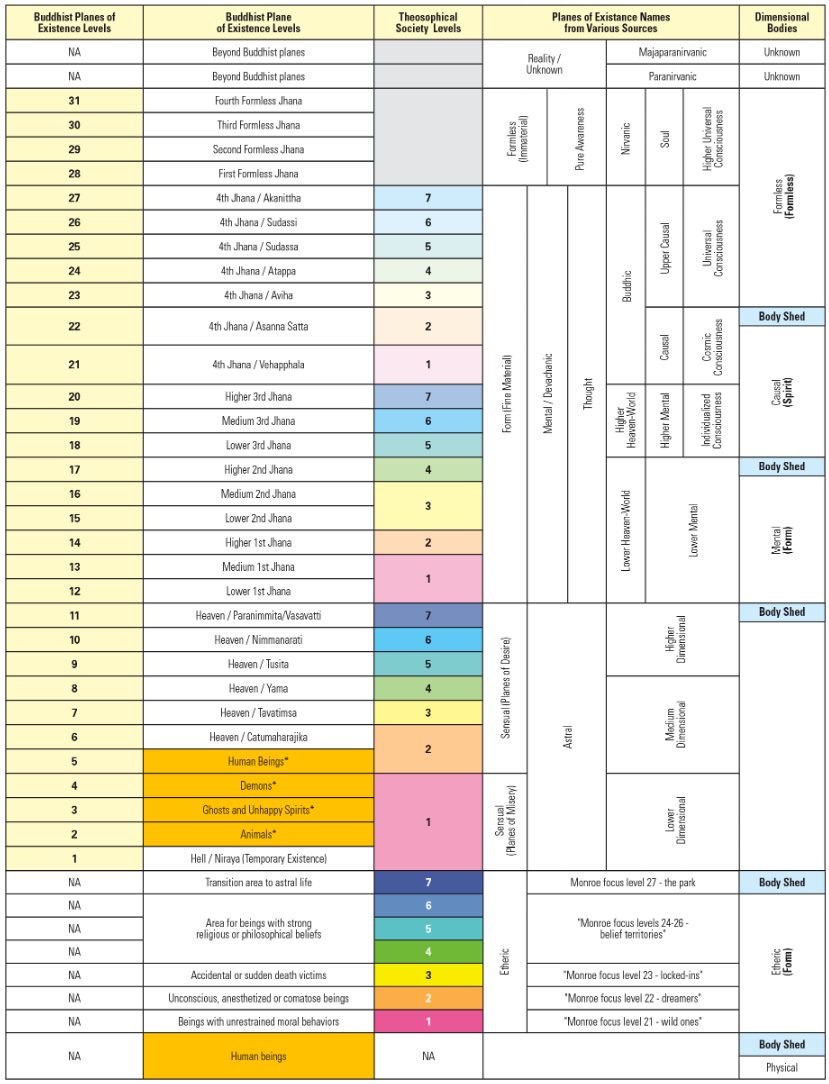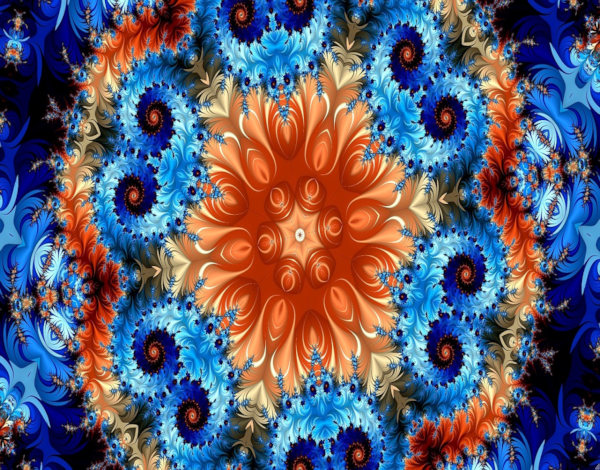Introduction
A number of spiritual cosmologies have been written over the centuries – and they are difficult to understand. This is because, my contention, people read them without understanding the underlying infrastructure about which they are speaking. I like to use an analogy about mobile phones to describe this need. How do two mobile phones, separated by hundreds of miles, communicate with each other? You can’t explain it without also explaining how the underlying infrastructure works – the cell towers, computers and data networks, that link the two phones together.
The same is true with spiritual cosmologies, and when I say “spiritual cosmology” I mean cosmologies that discuss the non-physical universe. The first section of my book, Christianity from a Spiritual Perspective, introduces an infrastructure framework, providing a graphical representation of the non-physical world. This information was compiled from ancient Buddhist scripture, works by the Theosophical Society and more recent autobiographical accounts written by Out-of-Body Experience (OBE) explorers. Once you understand some of the basic concepts represented in the chart, you will be better able to understand the ideas conveyed in spiritual cosmologies.
The Infrastructure of the Afterlife
The Infrastructure of the Afterlife chart is described in greater detail in my book, but here are some major features and some concepts to help you better understand the spiritual cosmologies described in this section.
Features
The chart is divided into five columns that describe the different dimensions in the non-physical world.
- The first two columns show the Buddhist thirty-one planes of existence, which are different levels of physical and non-physical existence described in Buddhist writings. They are used in this chart as the foundation upon which other information is presented, because it is so detailed.
- The third column, which is described further in the concepts, divides each dimension shown in the chart into seven sections. The change in the color shading represents the change in the density of each dimension as you move from the bottom (the physical dimension) to the top (the formless dimension) of the chart.
- The fourth column shows the different names given to the various dimensions and how they align with each other. The most commonly used names for these dimensions are the physical, etheric, astral, mental, causal and formless.
- The fifth column shows the different bodies that we inhabit in each dimension. It also dispels the human concept of death as a permanent loss. What this shows is that when our active consciousness moves from a more dense (see column three description) to a less dense dimension, we shed the more dense body, as indicated in the blue rows, when we inhabit the less dense one. In short, this chart shows that our consciousness does not die, but instead moves its existence from one dimension to another.
Concepts
These concepts are not directly stated in the chart, but their understanding will help explain aspects of the chart’s content. Again, these concepts are described in greater detail in my book.
- Reality is Wave-Based: This chart assumes that reality is wave-based and that that our physical existence consists of wave-based particles. Also, just as television, radio and wi-fi data communications co-exist in the same physical space, multiple wave-based realities can co-exist within the same space by vibrating at different frequencies.
- Reality is Multi-Dimensional: Multiple dimensions can also co-exist in the same space by interpenetrating each other with different densities. To understand the concept of interpenetration, imagine a large glass jar with a stack of large stones, small pebbles and sand beside it. When the large stones fill the jar, there are still gaps between the stones that the pebbles can fill. Once the pebbles fill the jar, sand can be poured in to fill the gaps between the pebbles. In this way, the large stones, pebbles and sand interpenetrate each other in the same space.
- Dimensions Become Less Dense as you Move Higher: As our consciousness moves into higher dimensions, it moves into increasingly less dense three-dimensional existences. The goal is for our consciousness to exist as a point of pure energy, but we have to gradually transition from a form-based body to this formless one.
- Our Consciousness Spans Multiple Dimensions: Our consciousness exists in the higher mental dimension (per the Theosophical Society), with a piece of it descending into ou physical dimension bodies by inhabiting a body in each of the lower dimensions as it moves through them. This implies that death is simply the movement of our consciousness between a more- or a less-dense dimension, as indicated by the blue rectangles on the right-hand side of the chart.
- Our Consciousness is Eternal. For the universe to be eternal, it must be cyclical, meaning that it runs in never-ending cycles, just as the earth circles the sun and the sun circles the galaxy. The same is true for our consciousness. For our consciousness to be eternal, it must also be cyclical. This means that as our consciousness evolves beyond the earth, there will come a time when it will come back, and if not to earth to another planet of a similar nature.
Figure 1: The Infrastructure of the Afterlife Chart

Buddhist Cosmology
During our human existence on earth, Buddhists say that we should focus on ridding our consciousness of its animal-like nature, such as anger, jealousy and revenge, through the development of morals, virtues and ethics.
Discussion
During our human existence on earth, Buddhists say that we should focus on ridding our consciousness of its animal-like nature, such as anger, jealousy and revenge, through the development of morals, virtues and ethics. As we evolve into a non-physical form, we should focus on detaching ourselves from the emotions and ego found in the physical world. This means that we should distance ourselves from our physical nature and our attachment to the physical dimension things around us. People in the Eastern hemisphere are more familiar with this cosmology than people in the west, as exemplified by the great number of practicing yogis, rishis and other spiritual leaders living in and around the Himalayan mountain range.
Buddhists cosmology describes thirty-one separate levels of existence (the yellow rows in the left-most column of the chart) that represent ever increasing levels of mastery of the will and concentration. They are divided into three groups:
- The Sensual World (planes 1-11) include our physical world, as well as planes of misery and happiness, where we live between our lives on earth. The planes of happiness correspond with the chart’s astral dimension levels.
- The Form Realm (planes 12-27) consists for four different levels of concentration, called jhanas. As we gain greater control over our thoughts, we ascend into higher jhanas, which are increasingly thought-responsive. This means that the higher our consciousness ascends, the more easily our thoughts can create what we imagine. In the fourth jhana, we will shed what remains of our form-like body to prepare us for a formless existence.
- The Formless Realm (planes 28-31) are four planes that can only be entered through deep meditation techniques. Per Buddhist cosmology, beings here have no form and live a long time.
Hindu Cosmology
Hindu cosmology describes changes in the universe over time and how time moves in cycles, similar to what we covered in the introduction and the Infrastructure of the Afterlife chart discussion. Each universe in the Hindu cosmology exists for a specific period of time, which is billions of earth years in length.
Discussion
Hindu cosmology describes changes in the universe over time and how time moves in cycles, similar to what we covered in the introduction and the Infrastructure of the Afterlife chart discussion. Each universe in the Hindu cosmology exists for a specific period of time, which is billions of earth years in length. On a separate note, there is a unique book worth mentioning here, Lemurian Scrolls by Satguru Sivaya Subramuniyaswami, that is particularly interesting. Its content was derived clairvoyantly and contains the story of humanity’s journey to earth from the Pleaides star system and other planets, early life in ancient Lemuria and its spiritual culture, and the struggles faced as souls matured over time.
Theosophical Society Cosmology
The Theosophical Society was created in the late 1800’s with the objective of creating a universal brotherhood of humanity, without distinction of race, creed, sex, caste o color. Its members would also publish books that attempted to explain supernatural events and human abilities that some world religions would describe as miracles or mysteries.
Discussion
The Theosophical Society was created in the late 1800’s with the objective of creating a universal brotherhood of humanity, without distinction of race, creed, sex, caste o color. Its members would also publish books that attempted to explain supernatural events and human abilities that some world religions would describe as miracles or mysteries. One author, Arthur E. Powell would write five compendiums in the 1930’s that would serve as a gateway into a much larger set of theosophical works. In these books, on humanity’s four non-physical bodies and the process of spiritual evolution, every paragraph referenced the source of its information, including the book and page number, in the outside margin. Author Charles W. Leadbeater wrote books on the Astral and Mental dimensions, describing the characteristics of each dimension and the beings that inhabited it. Leadbeater and Annie Besant, another theosophical society leader, also wrote a book in which ninety-seven atomic elements were drawn, as they exist in their normal state, and it showed how they decomposed into both physical and etheric components.
Experiential Cosmologies
Out-of-Body Experience (OBE) explorers have written about the non-physical world in autobiographical accounts of their travels beyond the etheric dimension, which is dimension people emerge into when they have their first OBE experiences.
Discussion
Out-of-Body Experience (OBE) explorers have written about the non-physical world in autobiographical accounts of their travels. Note that a number of books have been written on the process for achieving an OBE. We are talking here about books written by OBE explorers who travelled into dimensions beyond the etheric dimension, were most individuals remain during their OBE. Robert Monroe is the most popular of the authors mentioned here. He wrote three books in which he documented his increasingly distant travels. The first book covered his experiences in the etheric world. In his second, he describes his travels in the Astral dimension. His third book documents his most distant journey, in which he traveled to the lower causal dimension.
The second author, William Buhlman, is an instructor at The Monroe Institute, which Robert Monroe founded in the 1970’s. Buhlman teaches the OBE Intensive program there and has over twenty years of experience exploring the non-physical universe. In his book, Buhlman describes how to move between dimensions and maintain a non-physical state. The third author, Jurgen Ziewe, provides a broader view of the non-physical universe along with some unique experiences. In one, Ziewe asked to be shown how the universe began, and instead of witnessing the Big Bang, which is what he was expecting, he instead heard four separate audible tones.
Mark Hunter Brooks, author of the book Christianity from a Spiritual Perspective, has had numerous spiritual experiences since 2003 that have profoundly changed his worldview. He writes and speaks about the mechanics of the non-physical world to help demystify what has traditionally been a taboo topic.


Recent Comments